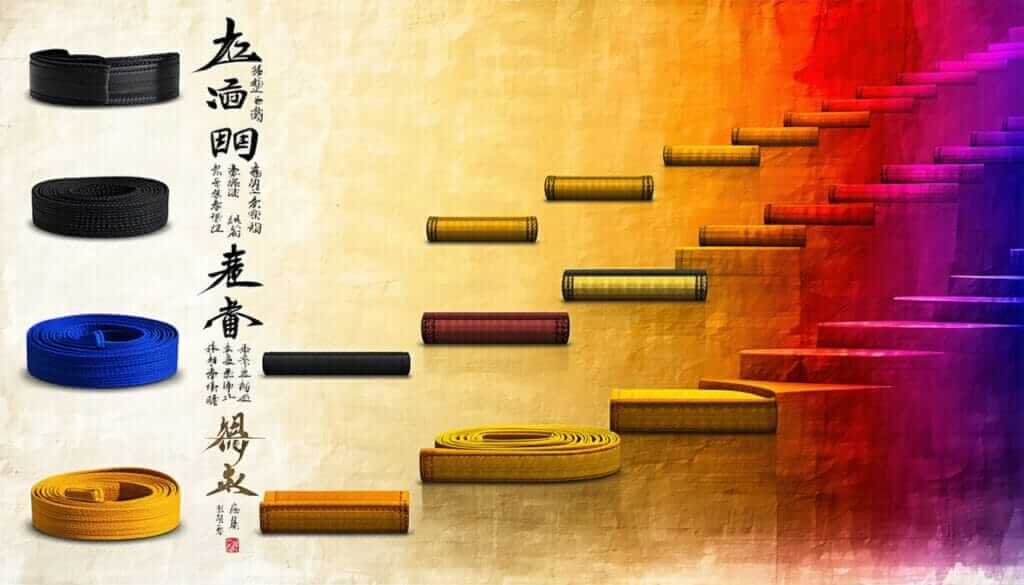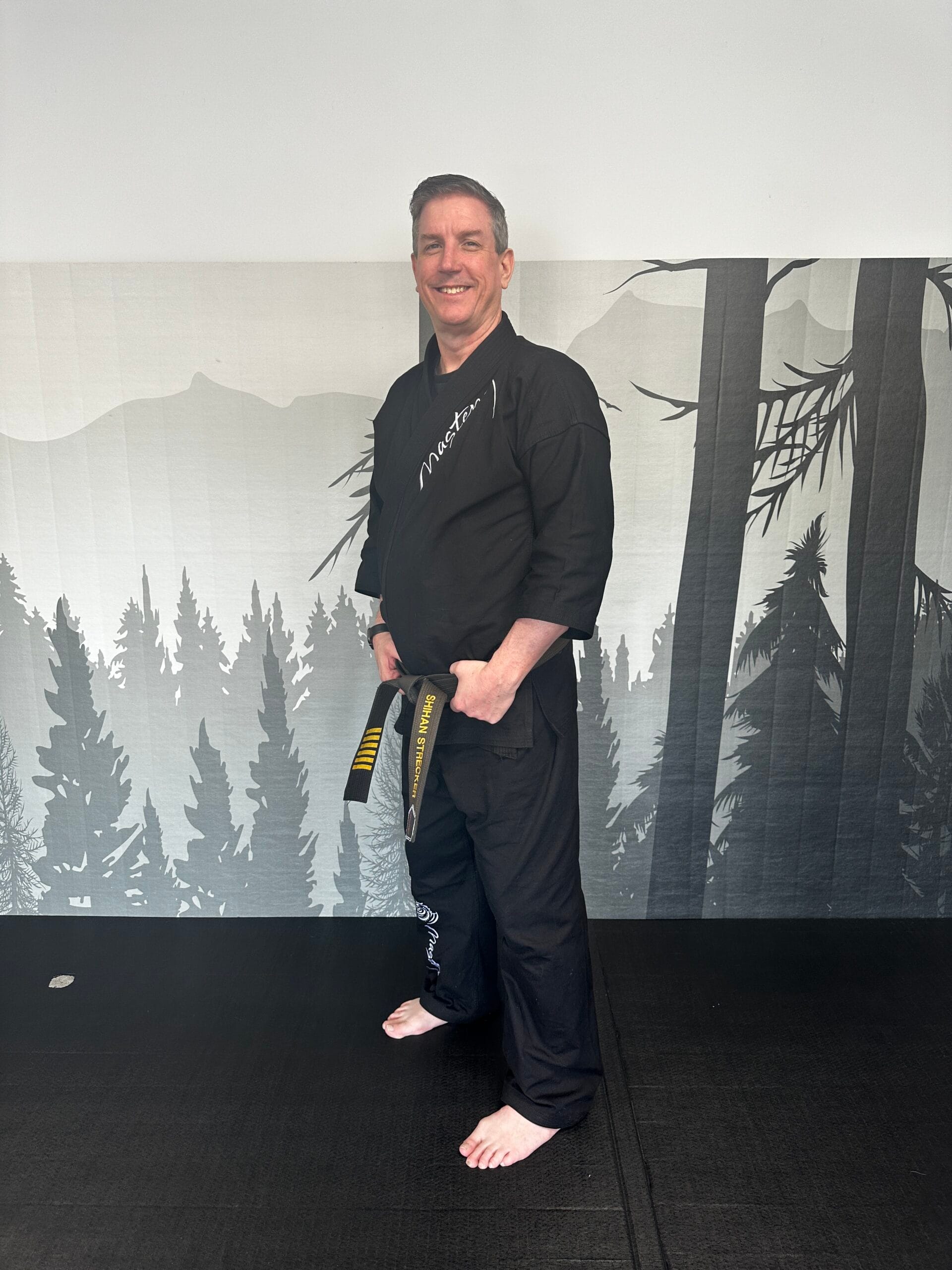Martial Arts Belt Rank Traditions
Ever wondered why some folks have different colored belts when practicing martial arts? Let’s break down how these rankings got their start and why they mean so much to practitioners across the globe.
Origins of Belt Rankings
The whole idea of colored belts in martial arts kicked off thanks to Judo’s founder, Jigoro Kano, back in the early 1900s. He devised a color-coded grading system using belts to represent a student’s skill level visually. It started a trend. Soon, other martial arts like Karate and Kung Fu were on board too.
This colorful belt system is pretty smart. Start with white for beginners, and work your way through the rainbow. It all finishes off with the prestigious black belt, showing you’ve got serious game. Check out more about how it all started here.
| Rank Level | Belt Color |
|---|---|
| 1 | White |
| 2 | Yellow |
| 3 | Green |
| 4 | Blue |
| 5 | Brown |
| 6 | Black |
Evolution of Ranking Systems
As time went on, martial arts styles mixed it up when it came to rankings. Kung Fu, for instance, decided on sashes instead of belts. They’re wider and wrapped on the side, paying homage to their own martial arts customs.
Karate added its own flavor, using belt colors to mirror the stages of a plant’s life. Starting with white, the beginner belt, the colors reflect growth, eventually leading to the black belt—a mark of deeper understanding and expertise.
Many martial arts continue to tweak their belt systems, adding all kinds of colors and levels. It helps paint a fuller picture of a student’s journey. Curious for more stories? Check out how these rankings evolved here and there.
These belt traditions have built a rich history of meaning and symbolism, guiding martial artists as they refine their skills and grow.
Kung Fu Belt Ranking System
Transition from Judo to Kung Fu
Back in the day, martial arts training was all about learning under a master until you got the hang of things—no belts, no formal rankings. But then came the early 1900s, shaking things up like a karate chop. Thanks to Judo’s colorful belt system—pioneered by the visionary Jigoro Kano—martial arts like Kung Fu started seeing the wisdom in tracking progress with some flair and structure.
Judo flaunted its colorful belts to show off skill levels and then other arts, including Kung Fu, thought, “Hey, that’s nifty!” So, Kung Fu got its own swagger, adopting a belt system akin to Karate and other martial arts, making it easier for students to see how far they’ve come and how much farther there is to go, like a martial arts GPS.
Significance of Sashes in Kung Fu
Step aside belts—Kung Fu’s all about the sashes. They’re not your regular run-of-the-mill belts either—these babies are a bit wider and are strapped around the side, flaunting them like a championship belt. It’s a stylish nod to Kung Fu’s rich history and culture, keeping it distinct from the rest of the martial arts world.
The color of a sash isn’t just about looking snazzy; it tells everyone around how much you’ve learned and grown. Just like other martial arts, each color represents a step on your Kung Fu adventure. Curious about what the colors mean across the martial arts universe? Check out our detailed run-down on martial arts belt colors meaning.
Here’s the lowdown on Kung Fu sash colors:
| Sash Color | Rank Level |
|---|---|
| White | Freshman Fighter |
| Yellow | Getting There, Buddy |
| Green | Making Waves |
| Blue | Almost a Sensei |
| Red | Martial Maestro |
| Black | Kung Fu Mastermind |
This sash system isn’t just about boasting rights; it’s a real shot in the arm for motivation, bringing everyone in the Kung Fu dojo together like family. To really wrap your head around where this system came from, dive into the past with our exploration of martial arts belt rankings history and see how it all evolved into what it is today.
Karate Belt System
Understanding the karate belt system is like hearing the heartbeat of martial arts. It gives martial artists a roadmap, showing how far they’ve come and where they might go next. The colors aren’t just for show—they’re deep with meaning, each telling a bit of the story about the spiritual and growth path of a karate student.
Symbolism of Belt Colors
Karate belt colors aren’t random—they’re as thoughtfully chosen as the strokes of a master painter. From a tiny seed to a towering oak, these colors mirror the life cycle. Starting with the white belt, which stands for a new beginning, much like a baby entering the world. Next, there’s purple and brown, symbolizing a shift from youth to the grown-up world of responsibilities and insights. The black belt? Well, that’s mixed with decades of sweat, a testament to wisdom and skill.
| Belt Color | Symbolism |
|---|---|
| White | Birth and potential |
| Purple | Development and growth |
| Brown | Maturation and mastery |
| Black | Enlightenment and expertise |
Every change of color isn’t just about fighting prowess; it’s like a journal entry, marking personal milestones inside and outside the dojo, reflecting the circle of life and personal growth.
Mastery and Proficiency in Karate
Grabbing a black belt in karate—it’s the stuff dreams are made of. But don’t think of it as the final stop. Instead, it’s a new beginning, where skills are honed and teaching others becomes part of the story.
Owners of black belts are not just at the top—they’re forever students, climbing through dan levels. Going from first dan (shodan) to tenth dan (judan), they’re forever learning, embodying the best of karate methods.
| Dan Level | Description |
|---|---|
| 1st Dan (Shodan) | First level of black belt – proficiency |
| 2nd Dan (Nidan) | Advanced knowledge and teaching ability |
| 3rd Dan (Sandan) | Further mastery and deeper expertise |
| 4th Dan (Yondan) | Higher-level proficiency |
| 5th Dan (Godan) | Significant achievement in karate |
| 6th Dan (Rokudan) | Advanced levels of teaching and knowledge |
| 7th Dan (Nanadan) | Critical thinking and deep understanding |
| 8th Dan (Hachidan) | Distinguished level of mastery |
| 9th Dan (Kyudan) | Near mastery level, high respect |
| 10th Dan (Judan) | Pinnacle of karate expertise and elevated status |
Borrowed from Judo, the kyu/dan system lets karate students climb the ladder of skill, giving them not just a way to measure how good they are, but serving as a motivational push to keep aiming higher. To get more steeped in the history of these belt stories, take a peek at our deep dive into martial arts belt ranking history.
Dan System in Martial Arts
The Dan system is the go-to ranking method in martial arts, especially in Karate. It mirrors not just the skill but the sweat and dedication of devotees, marking their milestones in the martial arts training track.
Proficiency Levels
Dan rankings generally span from 1st Dan (Shodan) to the elite 10th Dan (Judan). Each level is like a badge pinning a martial artist’s progress and prowess in their journey.
| Dan Level | Name | What’s the Scoop? |
|---|---|---|
| 1st Dan | Shodan | First hop; beginner/mastery nod |
| 2nd Dan | Nidan | Second peg; keeps the skill momentum going |
| 3rd Dan | Sandan | Third notch; mastery break-in and application |
| 4th Dan | Yondan | Fourth ring; marks notable skill and teaching chops |
| 5th Dan | Godan | Fifth spot; expert and the Yoda of performance |
| 6th Dan | Rokudan | Sixth insight; savvy philosopher of the martial realm |
| 7th Dan | Nanadan | Seventh crown; the Jedi of their discipline |
| 8th Dan | Hachidan | Eighth badge; grandmaster and teaching ace |
| 9th Dan | Kyudan | Ninth rung; community influencer |
| 10th Dan | Judan | The tenth; crowned king or queen of mastery worldwide |
Climbing the Dan ladder demands meeting exact criteria, passing tests by showing off physical prowess, mental grit, tactical knowledge, and pure respect for the craft.
Progression Beyond Black Belt
Snagging a black belt ain’t just an endgame; it’s a new beginning. It signifies a significant amount of learning, dedication to the art, and a grasp of core skills. But why stop at black? Higher Dan ranks beckon for shinier knowledge and sharper skills.
This black belt serves not just as proof of mastery but as a lighthouse guiding further enlightenment on the martial arts highway, NKKF. As martial artists move past the 1st Dan, they’re nudged towards boosting the Dojo spirit—teaching others, championing their art, and carrying martial virtues of respect and discipline like a flag.
Higher ranks bring bigger shoes to fill, including mentoring fledgling students. Many shoot for the 10th Dan—an epitome of mastery in their martial saga.
The Dan system shines a spotlight on both an individual’s martial trek and a community-centered approach to learning. Curious about how belt colors play into all this? Catch the story on martial arts belt colors meaning.
Historical Influence on Belt Rankings
Impact of Jigoro Kano
You can thank Dr. Jigoro Kano for making those colorful karate belts famous. He’s the brains behind Judo too. Back in the 1880s, Kano cooked up a belt system. There were just two colors at first: white for the rookies, and black for the pros. Around then, a structured ranking system for martial arts was born.
Kano gave martial arts a way to really see who knows their stuff. This gave students a chance to strut their stuff in levels. Eventually, other colors hopped on board to mark student growth. In 1922, Gichin Funakoshi, the karate wonder behind Shotokan, gave Kano’s ranking plan a twist for karate folks.
| Rank Level | Belt Color | Participants |
|---|---|---|
| Kyu | White | Beginners |
| Dan | Black | Advanced practitioners |
Adaptation by Karate Founders
Turning Kano’s blueprint into a more colorful spectrum was all thanks to karate legends who wanted to do their own thing while keeping that structured vibe. Funakoshi and the crew took Kano’s method and made it their own, adding belts of many hues to show off different skills.
That belt-color ladder changed the game, letting students see their hard work pay off with each new shade they earned. It was like a rainbow of achievement, each color a step closer to the top, just like in Kano’s kyu/dan setup.
The belt party didn’t stop at Japan, though. Mikinosuke Kawaishi brought the belt game to France in 1936, making it simpler for folks there to track progress without sticking to long, traditional Japanese timelines.
Today, this belt ranking game has spread across the globe, fitting into styles like Taekwondo and Jiu-Jitsu. It shows how central those colorful belts are in martial arts.
Belt Colors in Taekwondo
Progression and Symbolism
In the vibrant world of Taekwondo, the belt colors represent more than just an accessory. They tell a story of a student’s growth, effort, and achievements in this dynamic martial art. The belt system, borrowed from structures created by Jigoro Kano in Japan, takes you from newbie to master. The path takes you through six key colors: white, yellow, green, blue, red, and black. Each one stands for stages in your Taekwondo journey, highlighting how far you’ve come and where you’re going next.
| Belt Color | What It Means |
|---|---|
| White | The fresh start, full of potential and excitement |
| Yellow | Building your basics, like the first beams of a sunrise |
| Green | Sprouting knowledge, moving from beginner to more seasoned |
| Blue | Reaching higher, growing like the sky’s the limit |
| Red | Watch out, it’s all about careful development and skill refinement |
| Black | True mastery, a mix of wisdom, skill, and ongoing learning |
Kicking it off with a white belt, students embrace their new journey into Taekwondo. As they tackle the colors, their skills and dedication grow, aiming for the elite black belt, a marker of deep expertise and the start of even further exploration.
Attaining Mastery through Belts
Reaching for mastery in Taekwondo isn’t just about collecting colors on a belt. It’s a testament to the discipline, skill, and respect a student acquires. Moving between colors requires more than just knowing moves—it’s about embracing the core values of Taekwondo, such as respect and discipline.
The black belt? It’s not just the finish line. It’s the springboard into richer understanding and deeper dives into Taekwondo’s art and philosophy. Even with a black belt tied around the waist, students keep learning, exploring ranks beyond, which mirror lifelong dedication to growth and craftsmanship (KTMA Singapore).
In martial arts, especially Taekwondo, these vibrant belts are more than just signs of skill. They capture the spirit of personal development and a promise to the art’s lifelong practice. Curious about how belt ranking got its roots or more on symbolism? Check out our pages on martial arts belt ranking history and martial arts belt ranking symbolism.




